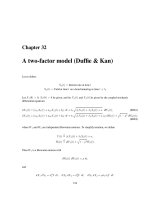A two-factor model (Duffie & Kan)
Bạn đang xem bản rút gọn của tài liệu. Xem và tải ngay bản đầy đủ của tài liệu tại đây (123.39 KB, 6 trang )
Chapter 32
A two-factor model (Duffie & Kan)
Let us define:
X
1
t=
Interest rate at time
t
X
2
t=
Yield at time
t
on a bond maturing at time
t +
0
Let
X
1
0 0
,
X
2
0 0
be given, and let
X
1
t
and
X
2
t
be given by the coupled stochastic
differential equations
dX
1
t=a
11
X
1
t+a
12
X
2
t+b
1
dt +
1
q
1
X
1
t+
2
X
2
t+dW
1
t;
(SDE1)
dX
2
t=a
21
X
1
t+a
22
X
2
t+b
2
dt +
2
q
1
X
1
t+
2
X
2
t+ dW
1
t+
q
1,
2
dW
2
t;
(SDE2)
where
W
1
and
W
2
are independent Brownian motions. To simplify notation, we define
Y t
4
=
1
X
1
t+
2
X
2
t+;
W
3
t
4
= W
1
t+
q
1,
2
W
2
t:
Then
W
3
is a Brownian motion with
dW
1
t dW
3
t= dt;
and
dX
1
dX
1
=
2
1
Y dt; dX
2
dX
2
=
2
2
Y dt; dX
1
dX
2
=
1
2
Y dt:
319
320
32.1 Non-negativity of
Y
dY =
1
dX
1
+
2
dX
2
=
1
a
11
X
1
+
1
a
12
X
2
+
1
b
1
dt +
2
a
21
X
1
+
2
a
22
X
2
+
2
b
2
dt
+
p
Y
1
1
dW
1
+
2
2
dW
1
+
2
q
1 ,
2
2
dW
2
=
1
a
11
+
2
a
21
X
1
+
1
a
12
+
2
a
22
X
2
dt +
1
b
1
+
2
b
2
dt
+
2
1
2
1
+2
1
2
1
2
+
2
2
2
2
1
2
q
Y t dW
4
t
where
W
4
t=
1
1
+
2
2
W
1
t+
2
p
1,
2
2
W
2
t
q
2
1
2
1
+2
1
2
1
2
+
2
2
2
2
is a Brownian motion. We shall choose the parameters so that:
Assumption 1: For some
,
1
a
11
+
2
a
21
=
1
;
1
a
12
+
2
a
22
=
2
:
Then
dY =
1
X
1
+
2
X
2
+ dt +
1
b
1
+
2
b
2
, dt
+
2
1
2
1
+2
1
2
1
2
+
2
2
2
2
1
2
p
YdW
4
=Y dt +
1
b
1
+
2
b
2
, dt +
2
1
2
1
+2
1
2
1
2
+
2
2
2
2
1
2
p
YdW
4
:
From our discussion of the CIR process, we recall that
Y
will stay strictly positive provided that:
Assumption 2:
Y 0 =
1
X
1
0 +
2
X
2
0 + 0;
and
Assumption 3:
1
b
1
+
2
b
2
,
1
2
2
1
2
1
+2
1
2
1
2
+
2
2
2
2
:
Under Assumptions 1,2, and 3,
Y t 0; 0 t1;
almost surely,
and (SDE1) and (SDE2) make sense. These can be rewritten as
dX
1
t=a
11
X
1
t+a
12
X
2
t+b
1
dt +
1
q
Y t dW
1
t;
(SDE1’)
dX
2
t=a
21
X
1
t+a
22
X
2
t+b
2
dt +
2
q
Y t dW
3
t:
(SDE2’)
CHAPTER 32. A two-factor model (Duffie & Kan)
321
32.2 Zero-coupon bond prices
The value at time
t T
of a zero-coupon bond paying $1 at time
T
is
B t; T =IE
"
exp
,
Z
T
t
X
1
u du
F t
:
Since the pair
X
1
;X
2
of processes is Markov, this is random only through a dependence on
X
1
t;X
2
t
. Since the coefficients in (SDE1) and (SDE2) do not depend on time, the bond price
depends on
t
and
T
only through their difference
= T , t
. Thus, there is a function
B x
1
;x
2
;
of the dummy variables
x
1
;x
2
and
,sothat
B X
1
t;X
2
t;T , t=IE
"
exp
,
Z
T
t
X
1
u du
F t
:
The usual tower property argument shows that
exp
,
Z
t
0
X
1
u du
B X
1
t;X
2
t;T , t
is a martingale. We compute its stochastic differential and set the
dt
term equal to zero.
d
exp
,
Z
t
0
X
1
u du
B X
1
t;X
2
t;T , t
= exp
,
Z
t
0
X
1
u du
,X
1
Bdt+B
x
1
dX
1
+ B
x
2
dX
2
, B
dt
+
1
2
B
x
1
x
1
dX
1
dX
1
+ B
x
1
x
2
dX
1
dX
2
+
1
2
B
x
2
x
2
dX
2
dX
2
= exp
,
Z
t
0
X
1
u du
,X
1
B +a
11
X
1
+ a
12
X
2
+ b
1
B
x
1
+a
21
X
1
+ a
22
X
2
+ b
2
B
x
2
, B
+
1
2
2
1
YB
x
1
x
1
+
1
2
YB
x
1
x
2
+
1
2
2
2
YB
x
2
x
2
dt
+
1
p
YB
x
1
dW
1
+
2
p
YB
x
2
dW
3
The partial differential equation for
B x
1
;x
2
;
is
, x
1
B , B
+a
11
x
1
+ a
12
x
2
+ b
1
B
x
1
+a
21
x
1
+ a
22
x
2
+ b
2
B
x
2
+
1
2
2
1
1
x
1
+
2
x
2
+ B
x
1
x
1
+
1
2
1
x
1
+
2
x
2
+ B
x
1
x
2
+
1
2
2
2
1
x
1
+
2
x
2
+ B
x
2
x
2
=0:
(PDE)
We seek a solution of the form
B x
1
;x
2
; = exp f,x
1
C
1
, x
2
C
2
, A g ;
valid for all
0
and all
x
1
;x
2
satisfying
1
x
1
+
2
x
2
+ 0:
(*)
322
We must have
B x
1
;x
2
;0 = 1; 8x
1
;x
2
satisfying (*)
;
because
=0
corresponds to
t = T
. This implies the initial conditions
C
1
0 = C
2
0 = A0 = 0:
(IC)
We want to find
C
1
;C
2
;A
for
0
.Wehave
B
x
1
;x
2
;=
,x
1
C
0
1
,x
2
C
0
2
,A
0
Bx
1
;x
2
;;
B
x
1
x
1
;x
2
;=,C
1
Bx
1
;x
2
;;
B
x
2
x
1
;x
2
;=,C
2
Bx
1
;x
2
;;
B
x
1
x
1
x
1
;x
2
;=C
2
1
Bx
1
;x
2
;;
B
x
1
x
2
x
1
;x
2
;=C
1
C
2
Bx
1
;x
2
;;
B
x
2
x
2
x
1
;x
2
;=C
2
2
Bx
1
;x
2
;:
(PDE) becomes
0=Bx
1
;x
2
;
,x
1
+ x
1
C
0
1
+x
2
C
0
2
+A
0
,a
11
x
1
+ a
12
x
2
+ b
1
C
1
, a
21
x
1
+ a
22
x
2
+ b
2
C
2
+
1
2
2
1
1
x
1
+
2
x
2
+ C
2
1
+
1
2
1
x
1
+
2
x
2
+ C
1
C
2
+
1
2
2
2
1
x
1
+
2
x
2
+ C
2
2
= x
1
B x
1
;x
2
;
, 1+C
0
1
,a
11
C
1
, a
21
C
2
+
1
2
2
1
1
C
2
1
+
1
2
1
C
1
C
2
+
1
2
2
2
1
C
2
2
+ x
2
Bx
1
;x
2
;
C
0
2
, a
12
C
1
, a
22
C
2
+
1
2
2
1
2
C
2
1
+
1
2
2
C
1
C
2
+
1
2
2
2
2
C
2
2
+ Bx
1
;x
2
;
A
0
, b
1
C
1
, b
2
C
2
+
1
2
2
1
C
2
1
+
1
2
C
1
C
2
+
1
2
2
2
C
2
2
We get three equations:
C
0
1
=1+a
11
C
1
+ a
21
C
2
,
1
2
2
1
1
C
2
1
,
1
2
1
C
1
C
2
,
1
2
2
2
1
C
2
2
;
(1)
C
1
0 = 0;
C
0
2
=a
12
C
1
+a
22
C
2
,
1
2
2
1
2
C
2
1
,
1
2
2
C
1
C
2
,
1
2
2
2
2
C
2
2
;
(2)
C
2
0 = 0;
A
0
=b
1
C
1
+b
2
C
2
,
1
2
2
1
C
2
1
,
1
2
C
1
C
2
,
1
2
2
2
C
2
2
;
(3)
A0 = 0;
CHAPTER 32. A two-factor model (Duffie & Kan)
323
We first solve (1) and (2) simultaneously numerically, and then integrate (3) to obtain the function
A
.
32.3 Calibration
Let
0
0
be given. The value at time
t
of a bond maturing at time
t +
0
is
B X
1
t;X
2
t;
0
= expf,X
1
tC
1
0
, X
2
tC
2
0
, A
0
g
and the yield is
,
1
0
log B X
1
t;X
2
t;
0
=
1
0
X
1
tC
1
0
+ X
2
tC
2
0
+A
0
:
But we have set up the model so that
X
2
t
is the yield at time
t
of a bond maturing at time
t +
0
.
Thus
X
2
t=
1
0
X
1
tC
1
0
+ X
2
tC
2
0
+A
0
:
This equation must hold for every value of
X
1
t
and
X
2
t
, which implies that
C
1
0
=0;C
2
0
=
0
;A=0:
We must choose the parameters
a
11
;a
12
;b
1
; a
21
;a
22
;b
2
;
1
;
2
;;
1
;;
2
;
so that these three equations are satisfied.









